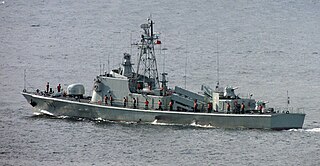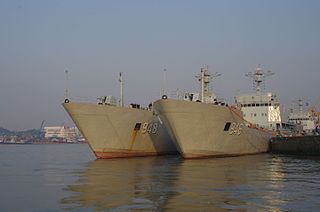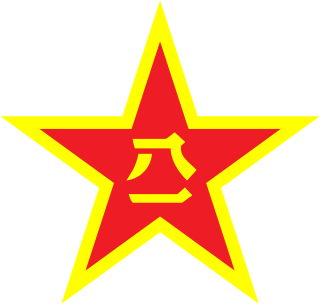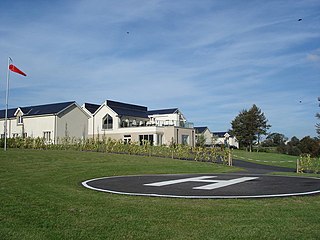
The People's Liberation Army Navy, also known as the PLA Navy, is the naval warfare branch of the People's Liberation Army, which is the armed wing of the Communist Party of China and, by default, the national armed forces of the People's Republic of China. The PLAN can trace its lineage to naval units fighting during the Chinese Civil War and was established in September 1950. Throughout the 1950s and early 1960s, the Soviet Union provided assistance to the PLAN in the form of naval advisers and export of equipment and technology. Until the late 1980s, the PLAN was largely a riverine and littoral force. However, by the 1990s, following the fall of the Soviet Union and a shift towards a more forward-oriented foreign and security policy, the leaders of the Chinese military were freed from worrying over land border disputes, and instead turned their attention towards the seas. This led to the development of the People's Liberation Army Navy into a green-water navy by 2009. Before the 1990s the PLAN had traditionally played a subordinate role to the People's Liberation Army Ground Force.

The People's Liberation Army Air Force (PLAAF) is the aerial warfare service branch of the People's Liberation Army, the armed forces of the People's Republic of China. The PLAAF was officially established on 11 November 1949. As of 2014, the PLAAF has a strength of around 398,000 personnel and is the largest air force in Asia.

The People's Liberation Army Naval Air Force is the naval aviation branch of the People's Liberation Army Navy.

The People's Liberation Army Navy Surface Force is a branch of the People's Liberation Army Navy. It consists of all surface warships in operational service with the PLAN. It operates 661 ships. The ships are organized into three fleets: the North Sea Fleet, the East Sea Fleet, and the South Sea Fleet. The People's Liberation Army Navy is turning away from its traditional focus on coastal and littoral warfare and instead prioritising the development of blue water capabilities. This has led to a significant reduction in fleet numbers as the PLAN has replaced a larger number of smaller ships with a smaller number of larger and more capable ships, including destroyers, frigates, corvettes, amphibious warfare ships and large auxiliary ships.

The Type 071 is a Chinese People's Liberation Army Navy (PLAN) amphibious transport dock. The Type 071 provides the PLAN with capabilities and flexibility not found in its previous landing ships.

The Type 037 corvette is a series 400–500 ton corvette type classes in service with the People's Liberation Army Navy. Unlike western navies, the People's Liberation Army Navy does not have dedicated patrol boats in its inventory. Instead, a large variety of corvette type classes, in the form of missile boats and submarine chasers fulfill the tasks of patrolling China's territorial waters. The Egyptian Navy operates eight vessels.
The Type 072 landing ship are large landing ships built by Shanghai-based Zhonghua Shipyard in the 1980s to replace the aging World War II-era ex-US Navy L-1511 tank landing ships in service with the PLA Navy. The Type 072 is the PLA Navy’s first indigenous large landing ship. A total of 3 Type 072 are in service all of them are in service with the East Sea Fleet of the People's Liberation Army Navy.
The Type 072II landing ship are large landing ships built by Shanghai-based Hudong-Zhonghua Shipyard as a successor to the Type 072 landing ship. A total of four hulls have been delivered to the PLA Navy since the early 1990s. The Type 072-II is the PLA Navy’s first amphibious warfare ship to have a flight deck for helicopter take-off/landing. There are four ships currently in People's Liberation Army service, three of which are deployed in South Sea Fleet of the People's Liberation Army Navy at Zhanjiang, Guangdong Province, while the remaining one is deployed in East Sea Fleet of PLAN. All active ships are built by China Shipbuilding Shipyard (中华造船厂) in Shanghai.

The Type 073 landing ship is a family of landing ships developed and operated by the People's Liberation Army Navy, it consists of several models. This article details the development of this class that begun in the 1960s. The most recent and modern model of the class is the Type 073A, which were built and commissioned in the 2000s.

The Type 905Fuqing-class auxiliary oiler replenishment is a class of auxiliary oiler replenishment (AOR) vessels used by the People's Liberation Army Navy and Pakistan Navy to resupply ships at sea with food, munitions, fuel and spare parts. One ship is now a commercial oil tanker in China. It is also known as Taicang class.
Beijun 204 class dredger is a class of little known naval auxiliary ship currently in service with the People's Liberation Army Navy (PLAN). The name of this class is after the first unit commissioned, with the exact type still remains unknown, and only a single unit of this class have been confirmed in active service as of mid-2010s. In comparison to other dredger in Chinese military service, Beijun 204 class is also capable of performing floating pile driver missions with two piles it is equipped with, one on each side of the ship.
Donghai Island class flow-on/flow-off ship is a class of little known naval auxiliary ship currently in service with the People's Liberation Army Navy (PLAN). The name of this class is after the first unit commissioned, with the exact type still remains unknown, and only a single unit of this class have been confirmed in active service as of mid-2010s, with pennant number 868. The flow-on/flow-off capability of the Donghai class is achieved via its semi-submersible hull design.
Nanjiao 90 class dispatch boat is a class of little known naval auxiliary ship currently in service with the People's Liberation Army Navy (PLAN). The name of this class is after the first unit commissioned, with the exact type still remains unknown, and a total of two units of this class have been confirmed in active service as of mid-2010s. Nanjiao 90 class has a narrow landing ramp built in the bow, the only Chinese naval dispatch boat with this feature.
Nanshui 701 class water tanker is a class of little known naval auxiliary ship currently in service with the People's Liberation Army Navy (PLAN). The name of this class is after the first unit commissioned, with the exact type still remains unknown, and only a single unit of this class have been confirmed in active service as of mid-2010s.
The Dongbo 39 class barge is a little known class of naval auxiliary ship currently in service with the People's Liberation Army Navy (PLAN). The name of this class is after the first unit commissioned, with the exact type still remains unknown, and only a single unit of this class have been confirmed in active service as of the mid-2010s.
The 3200-horsepower class tug is a little known class of naval auxiliary currently in service with the People's Liberation Army Navy (PLAN). Built by Wuhu Xinlian Shipbuilding Co., Ltd. (芜湖新联造船有限公司), formerly Wuhu Shipyard, since 2004, the name of this class is taken from the installed power of the vessels, with the exact type designation still remaining unknown. After the first pair was built, as of the mid-2010s, a total of twelve of this class have been confirmed as being in active service. The unit price of each ship is more than a hundred ¥.
Type 726 LCAC is a class of air-cushioned landing craft used by the People's Liberation Army Navy. Six Yuyi-class LCACs are believed to be in service with the People’s Liberation Army (PLA), with the first one (3320) being seen at the end of 2007. It is thought that the vessels were delivered in two batches, with the first three LCACs reportedly powered by Ukrainian UGT 6000 engines, while the remaining three are believed to use the indigenous QC-70 gas turbines. Up to four Yuyi-class LCACs can be carried in the well deck of the 210 m-long Yuzhao-class landing platform dock (LPD).











